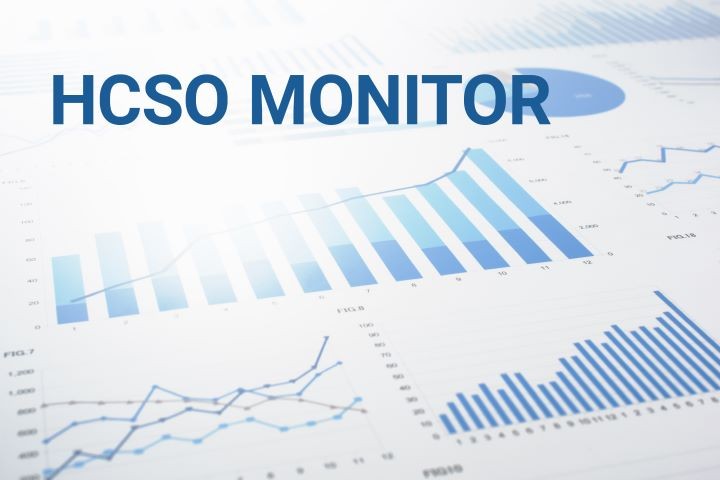Key figures
Inflation
Indicator description
Average change in the prices of goods and services purchased by households for own use, compared to the same period of the previous year. The consumer price index less 100 equals the inflation rate.
Source:
Summary tables (STADAT)
Latest data: –
GDP
Indicator description
Gross domestic product is the sum of gross value added produced by industries or sectors, valued at basic prices, and of the balance of taxes and subsidies on products, which cannot be divided by industry or sector, less financial intermediation services not divided by industry or sector. GDP volume change compared to the same period of the previous year is presented based on unadjusted data.
Source:
Summary tables (STADAT)
Latest data: –
Adjusted population
Indicator description
The full-scope censuses conducted every ten years show a comprehensive picture of the number and composition of the population. For determining the annual population number in the period between two censuses, the starting point is the population number of the last census (currently the census with the reference date of 1 October 2022), and from this, the population was estimated by using natural increase or decrease data available from the statistics of vital events until 2000. From 2001 international migration is also taken into account.
Source:
Summary tables (STADAT)
Latest data: –
Unemployment rate
Indicator description
The ratio of unemployed persons to the economically active population of corresponding age. The indicator can be calculated for different age groups, the default is the age group 15–74. Further selected age groups: 15–24, 25–54, 55–74.
Source:
Summary tables (STADAT)
Latest data: –
Employment rate
Indicator description
The ratio of employed persons to the population of corresponding age. The indicator can be calculated for different age groups, the default is the age group 15–64. Further selected age groups: 15–24, 25–54, 55–64 and 20–64.
Source:
Summary tables (STADAT)
Latest data: –
Industrial production
Indicator description
We measure changes of industrial production by variations of industrial production values, however the impact of price change is filtered out. We calculate the volume index of production based on comparative prices data of the industrial production value (presented at reference period price levels).
Source:
Summary tables (STADAT)
Latest data: –
Featured
HCSO Monitor
The collection of interactive figures provides up-to-date information on the latest domestic and international socio-economic trends.
The decisive part of the figures included in HCSO Monitor are downloadable in both image and data formats (PNG, SVG and CSV).
Feel free to browse the data in HCSO Monitor, updated many times a week!
Latest update: 16/10/2025
The decisive part of the figures included in HCSO Monitor are downloadable in both image and data formats (PNG, SVG and CSV).
Feel free to browse the data in HCSO Monitor, updated many times a week!
Latest update: 16/10/2025
Hungary in figures, 2023 – Economic Environment
The Economic Environment chapter of the Hungary in Figures, 2023 publication presents from different aspects (e.g. GDP, investments, price changes) the macroeconomic status of Hungary. The External Trade part reveals that the 2023 export level set a record (EUR 150 billion) in 2023, too, generating an EUR 9.0 billion surplus in our country’s external trade in goods; a higher level being registered only in 2016. The full publication can be viewed here: Hungary in figures, 2023.16/10/2025
Demographic Yearbook, 2024
In 2024, the number of births decreased to a greater extent than that of deaths, resulting in a slower pace of natural decrease. Life expectancy at birth rose to its highest level ever. The decline in the number of marriages continued. The Demographic Yearbook provides detailed data on the composition of the population, the changes in births, marriages, divorces and deaths, as well as the features of migration.
15/10/2025
15/10/2025
Regional Statistics, Volume 15, Number 5, 2025
The latest issue of the scientific journal features studies on the following topics: immigration and native labour market conditions in Argentina; food security through agricultural financing in Indonesia; spatial characteristics of the sex ratio shift in India; GDP per capita and human capital investment after the exhaustion of the first demographic dividend; community-led local development strategies; regional inequality in Mexico’s post-pandemic economic recovery; the conditional effects of Covid-19 on earnings management; sectoral structure of employment in EU member states.
13/10/2025
13/10/2025
Hungary in Figures, 2023
Hungary’s population was 9,585 thousand on 1 January 2024, nearly 18% of which lived in the capital, almost 53% in the remaining towns and 30% in villages. In 2023, Hungary’s surplus on external trade in goods reached its highest value (EUR 9.0 billion) after 2016 and the surplus on services grew to an all-time high (EUR 11.0 billion) as well. Both the production and the average yield of major arable crops rose, and the yield of barley increased to an unprecedented value (2.2 million tonnes).
13/10/2025
13/10/2025
Did you know? – Library
There were 24.6 million borrowings in Hungary's libraries in 2024; their total stock was reaching 155.6 million volumes.
If you liked it, check out our data visualisations at this link: www.ksh.hu/datavisualisations
13/10/2025
If you liked it, check out our data visualisations at this link: www.ksh.hu/datavisualisations
13/10/2025
In 2024/25, the domestic population on average spent less time on sleeping and more time on income producing activities compared to 15 years earlier
In 2024/25, the population in Hungary aged 15–74 devoted the most time daily, an average of 486 minutes, to sleeping, which is 21 minutes less than in 2009/10. An average of 287 minutes per day was allocated to leisure activities, and 207 minutes to income producing activities, representing an increase of 21 and 25 minutes, respectively, compared to 15 years ago. On average men compared to women spent more time on income producing activities and leisure pursuits, while on average women dedicated more time to household and domestic tasks, as well as childcare.
07/10/2025
07/10/2025
Snapshots, 2024 – Construction
Construction output (7 699 billion HUF) lagged behind the one year earlier level at comparative prices by 1.2% in 2024.Production in the two main groups of construction took opposite directions: the construction of buildings lessened by 2.7%, while civil engineering grew by 1.2%. The volume of new contracts concluded increased by 3.0% in 2024, the end of the year stock of contracts grew by 18.7% year-on-year. Construction producer prices were 5.9% higher than in 2023.
10/10/2025
10/10/2025
October 6, Memorial Day for the Martyrs of Arad
October 6th, the date of the execution of the 13 Martyrs of Arad, has been a national day of mourning since 2001 (pursuant to Government Decree 237/2001. (XII. 10.) on national mourning). A total of 128 death sentences were carried out between January 1849 and February 1850 as part of the retaliations following the 1848–49 Revolution and War of Independence. However, the sacrifice of those executed was not in vain; they became symbols of patriotism, solidarity, and national cohesion, setting our nation on the path of civic development.06/10/2025
World Space Week, 4–10 October 2025
World Space Week is held between 4 and 10 October each year, since the two dates refer to significant ones each in space research: Sputnik 1, the first man-made satellite was launched on 4 October 1957, and the treaty laying down that space research can be used only for peaceful purposes entered into effect on 10 October 1967. Hungary’s space history, thanks to Tibor Kapu’s mission, is written even today.
03/10/2025
03/10/2025
First releases
News, events
- HCSO representation at the 3rd International Statistics Forum, 14/10/2025
- The IT area of HCSO will be performing maintenance between 15:00 and 24:00 on (Friday) 17 October 2025, 10/10/2025
- HCSO publishes September motor fuel price statistics, 03/10/2025
- HCSO completes revision to EU-SILC data collection, 29/09/2025
- Never before have so many people been curious about the Palace of Statistics, 23/09/2025









